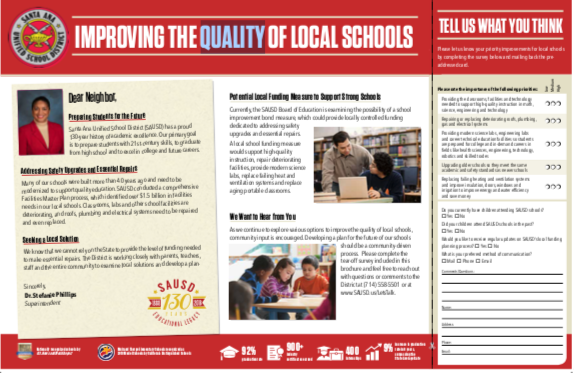School officials want you thinking how to spend millions, but not how they’ll get it
 Survey says? Whatever they want it to say.
Survey says? Whatever they want it to say.
Under the guise of measuring public opinion, Santa Ana school officials are trying to shape it – and they’re using taxpayer dollars to pay for it.
In April and May, Santa Ana Unified School District officials papered the city with mail that looks like a poll. The direct-mail campaign included questions about how residents would spend $479 million to “support high quality instruction, repair deteriorating facilities, provide modern science labs, replace failing heating and ventilation systems, and replace portable classrooms.”
Officials asked the questions in anticipation of a district-wide vote on a multi-million-dollar bond. On a 4-1 vote last month, the district’s board of trustees placed the bond on the November ballot.
State law allows government officials to communicate nonpartisan information, but not to engage in politicking.
“This mailing was neither a scientific survey or a poll or mere educational outreach,” said Will Swaim of the California Policy Center. “It was a push poll, an attempt by Santa Ana Unified officials to persuade voters, and that would be illegal under state law.”
A push poll is meant to promote a political message under the pretense of collecting public feedback.
The Santa Ana survey is part of a broader trend in California politics. “It’s now common for local officials seeking tax increases or bond issues from voters to hire campaign consultants on the fiction that they will provide unbiased information to the voting public,” said veteran political commentator Dan Walters.“These consultants conduct polling to determine which angles of proposals are most attractive to voters, write the measures to stress those popular features and then produce literature and ads to trumpet those selling points.”
On first glance, the Santa Ana mailing looks like an actual survey. The front page states, “Santa Ana Unified School District wants to hear from you.” On the second page, respondents are told that “developing a plan for the future of our schools should be a community-driven process.”
But the “survey” strongly implies that the bond is essential – and that it’s so likely to succeed at the polls in November that voters should start thinking about how they’d like to spend hundreds of millions of dollars.
These millions will come from Santa Ana residents and businesses – a fact the district downplays.
A bond is a loan that will be repaid by local taxpayers over a period of years. Public officials have priced the November bond all over the map – from $479 million when they first launched it, they soon raised the price tag to $518 million. More recently, without explanation, the district announced the bond was $232 million. None of those numbers include interest payments that will double the cost to taxpayers. The district is still paying off two previous bonds.
“Santa Ana’s campaign strategy is a little like sending your kids a bill in January for all the toys you gave them in December,” said Swaim. “Everybody’s excited to think about spending. It’d be great if district officials told their residents about the costs to individuals and businesses.”
One of the first things respondents saw on the April-May survey was a message in capital letters: “Improving the Quality of Local Schools.” The accompanying note from the district superintendent emphasizes the district’s pressing need for more cash.
Further, the survey asks respondents to rank their priorities on bond spending. The menu of options ranges from upgrading classrooms and repairing deteriorating roofs and electrical systems, to replacing failing heating and ventilation systems.
Critics say the district’s approval of every proposed teacher pay raise and rising pension debt is consuming so much money that almost nothing is left for facility maintenance or hiring new teachers. Hence, the November bond.
“Santa Ana can ill afford another tax increase,” says Art Pedroza, a Santa Ana resident and publisher of the website New Santa Ana. “Our residents include many seniors on fixed incomes and young families struggling to survive. This latest bond measure will raise their cost of living.
“Ultimately this bond measure is a gift to the unions at taxpayer expense.”
Kelly McGee is a Rhodes College (Memphis) graduate and CPC journalism intern.
